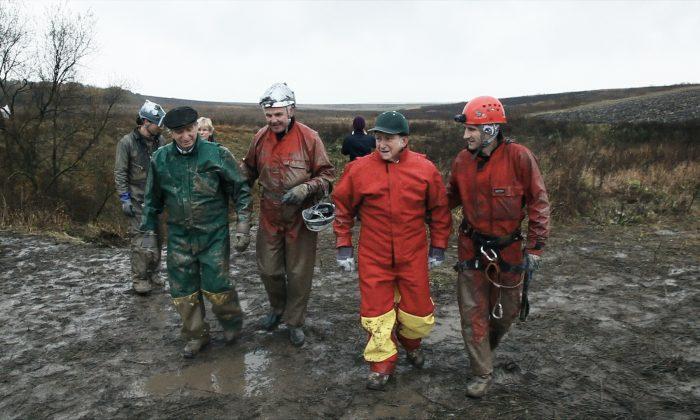Most think of caving as the stuff of National Geographic, but for 38 Jewish Ukrainians, it was rather more serious. It was a matter of life, not death.
For 18 months, they evaded the German National Socialists by hiding deep in two narrow, naturally formed caverns. Decades later, the survivors tell their story in Janet Tobias’s documentary, “No Place on Earth.”
As it often happens, it was a New Yorker who brought this story to light. British-born Bronx resident Chris Nicola is an experienced caver who originally traveled to the post-Soviet Ukraine in search of his roots. While exploring a cave, he discovered a series of artifacts clearly suggesting that families had once lived there.
Not surprisingly, the locals were not forthcoming with information. Nonetheless, after years of sleuthing, he finally tracked down the Stermers and the Dodyks. They all credit their initial survival to the iron will of matriarch Esther Stermer as well as the resourceful foraging of the elder Stermer brothers, Nissel and Saul.
When Tobias read about Nicola’s expeditions and investigation (in Nat Geo, of course), she recognized the makings of a good documentary. Fortunately, the production fell into place in time to record the elderly Stermer and Dodyk survivors returning to the caves that once sheltered them, bringing along their children and grandchildren, with Nicola to serve as their guide.
Tobias blends dramatic re-enactments, talking-head interviews, and her on-the-scene footage of the families’ underground homecoming (not completely seamlessly, but functionally enough). At times, it has the feel of a cable special (perhaps with good reason, considering it is a co-production of History Films), but there is no denying the power of their story.
At one point during their subterranean reunion, they cut the lights to fully recreate the experience of living there. Coincidentally, at this point the video went out at the screening I attended, yet it took a roomful of jaded film critics several minutes to realize it was supposed to be dark, but not that dark. One could certainly say we were caught up in the moment. (Eventually, the problem was fixed and the film rewound to the point in question).
The Stermer and Dodyk family members are still very sharp interview subjects, and Nicola is a particularly charismatic screen presence. As a result, Tobias captures a vivid sense of her subjects’ personalities and their lives in the caves, the quality of which was quite high, they repeatedly emphasize, because it was free.
Indeed, this is not the usual survival story often depicted on film, chronicling the efforts of a good Christian protector. The Stermers and Dodyks relied almost entirely on themselves. There is a lot to learn from their inspiring stories.
“No Place on Earth”
Director: Janet Tobias
Cast: Chris Nicola, Fruzsina Pelikán, Saul Stermer
Running Time: 1 hour, 23 minutes
Rating: PG-13
Rating: 3.5 out of five stars
Joe Bendel writes about independent film and lives in New York. To read his most recent articles, please visit http://jbspins.blogspot.com




